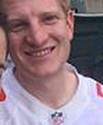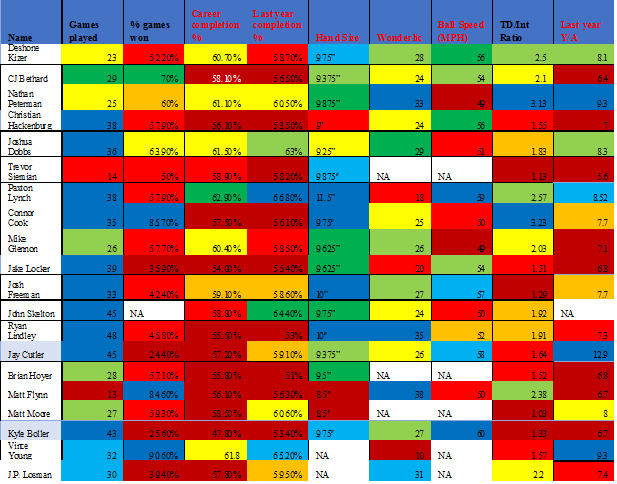Draft Strategies | Depth Charts | Mock Drafts | SOS | Tools | ADP
Diehards Staff Experts Poll | Draft Simulator | University Videos
What the Numbers Say About Success and Failure for Quarterbacks Part 2 Failure

High Hopes Dashed
It’s always disappointing when a team puts their hopes and dreams into a player, only to see that optimism drained over years of piss-poor performance. Nearly as sad is a fantasy player picking up a quarterback hoping they provide stability, and perhaps a championship, only for a series of turnovers and underwhelming performances to slowly sink their season. This article will help you avoid quarterback catastrophes by paying attention to the right characteristics.
Failure Signs
Completion Percentage: <60% career <58.5% last year
Through my literature review and personal research a few marquee characteristics have been revealed that spell disaster. /u/Jaguargator9 on Reddit.com has written a series of articles explaining that players who consistently fail to achieve a completion percentage of 58.5% in college never experience success in the NFL. Furthermore, he has found that over the last decade no quarterback has been successful with a last year yards per passing attempt (Y/A) of 7.3. After checking through all quarterbacks drafted in the first 6 rounds since the 2010 draft, along with each quarterback drafted in the first two rounds since 2004 the completion percentage standard is 100% correct. No quarterback since Michael Vick has had a successful career when they’ve thrown for less than a 58.5% completion percentage in their final year of college.
Beyond this benchmark, it is rare to see a quarterback succeed if they have failed to reach the conventional standard of a 60% completion rate in college. The logic stands strong here, moving from college to the NFL requires more precision and less sloppy play, the habits developed in college carry over to the NFL. Completion percentage has been found to be perhaps the most stable quarterback characteristic over the years.
One sign for optimism would be if a player increased their completion percentage every year they’re in college. Their early years yielded sub 58.5% performances, only to strengthen that stat later in their college careers. Players like: Matthew Stafford, Colin Kaepernick, Jay Cutler, and Lamar Jackson are just a few quarterbacks that fit this bill.
Yards per passing attempt <7.3
In the era of spread offenses where college defenses exist more to play a bit part instead of a leading role, it’s important to know that a quarterback can thrive when the conditions are looser. When a quarterback can’t average more than 7.3 Y/A in their last year of college, the data shows that they are almost certainly likely to fail. The last time we saw a quarterback with an average achievement lower than that was a different era in football. 2008 brought about the last QB who was successful with a Y/A under 7.3. This was an era before the wildcat, the read-option, the RPO and all the major hallmarks of the explosive college scene we’re used to seeing today. Thus, it would make sense that a complete quarterback could have been developed without a reliance on explosive plays like they do today.
Though today’s college game is extremely different, with a reliance on spread concepts and other concepts that give QBs far more opportunities for connecting on deep passes, it is expected to see a Y/A at 7.5 or above. If a leader fails to achieve this standard, it is heavily correlated with an inability to connect on deep passes which is crucial for many West-coast based pro-offenses. 24 quarterbacks since 2009 have been drafted with this red-mark on their resume and the only one left without a pink-slip is Ryan Tannehill who is playing for his job this year.
Actual Ball Velocity: <50MPH
According to the data I’ve accumulated, no quarterback who exhibits a top-end throwing velocity under 50MPH has been successful in the modern NFL. Furthermore, the closer to 50MPH a player tops out at, the worse their chances for success are as a professional. Players like Mike Glennon, Nathan Peterman, Connor Cook, and John Skelton legitimately don’t have enough arm strength to make the throws necessary to succeed in the NFL. It has been found that a two-MPH change in ball velocity translates into a three-foot difference on a twenty-yard throw in the same time frame. The means that without a strong enough arm, a quarterback will consistently struggle to fit balls into tight windows. A quarterback is asked to fit balls into tight windows multiple times every game, if they cannot rise to the occasion, the result is often a turnover.
Arm speed is an unfortunate requisite for NFL success. A cerebral quarterback can’t seem to shake the standards that world class athletes bring to the table.
Wonderlic score: <20 for white quarterbacks, unknown for others.
Although, controversial it has been reliably shown going back to K.F. Gesinger’s 2001 article, Review of the Wonderlic Personnel Test and Scholastic Level, that the Wonderlic test is racially biased. Gesinger found that there was a significant difference between Caucasian and other players in final scores, where white players scored significantly higher on average. The reason I bring this up is that there are no examples in the model of a Caucasian quarterback succeeding in the NFL if they score lower than a 20 on the Wonderlic. Though, when one looks at the data for African American quarterbacks, the outcomes become more muddled. Players like Donovan McNabb (15) and Tyrod Taylor (15) break the trend and have done well in the NFL. Though for anyone scores below 15 have been damning.
The claim I am making in this article is that there is unlikely a legitimate difference in intelligence between the races, but the Wonderlic test itself is racially biased, and thus artificially lowers scores for non-white quarterbacks. Recent tests like the AIQ supposedly controls for racial bias, and if these scores ever become publicly available, I wager this difference in performance would largely disappear.
Once again, as with each of these characteristics, the incidence of success decreases the closer a player gets to the failure threshold. On average, the higher a Wonderlic score the rosier a player’s prospects become, while any score that edges closer to 20 is cause for concern.
Hand Size: <9 inches
Since 2000, only two quarterbacks have been successful with hands smaller than 9 inches, Michael Vick, and Tony Romo. The hard and fast rule in the NFL over the last two decades has been that without at least nine-inch hands, the quarterback will fail due to difficulty being able to grip and manipulate the ball in inclement weather, or otherwise. This is largely due to the fact that NFL footballs are half an inch longer, and one inch larger in circumference compared to the balls used in college. This may not seem like a lot, but if one’s hands are just large enough to wrap around and manipulate a college ball, it’s going to be tougher to work with a larger NFL ball. At the very least, small hands will serve as a tie-breaker to make an analyst feel more confident in their read on a prospect.
Once again, the data shows that smaller hands often lead to tougher times in the NFL with only a few exceptions including: Ryan Tannehill (9”), Jared Goff (9”), and Colin Kaepernick (9.125”).
Data in Action
• The model includes all quarterbacks that have started more than five games since the year 2002.
• Here is a list of all quarterbacks that have one or more of the listed failure conditions listed through this article.
• The players are listed in order of newest to oldest. Rookies are excluded and will be elaborated upon in part 4 of this series.
QB Bust List


Looking Over the Numbers
After analyzing the data, it becomes clear there are a certain number of characteristics that must be met by franchise quarterbacks if they hope to thrive in the NFL. Of the quarterbacks listed nearly all are unmitigated busts except for Jay Cutler, whom didn’t fall under the 58.5% threshold for completion percentage his last year in college. Furthermore, Cutler had several high-grade success characteristics including: games started, ball velocity and Y/A. Cutler is amongst the rare QBs who flirted with the failure benchmarks but kept his head just above water. Cutler’s overall upside, just like Matt Ryan’s was sufficient to make up for his faults, though it seems that no amount of potential can overcome performance that has doomed quarterbacks for a generation.
The jury is still out on the likes of Nathan Peterman and Deshone Kizer, but the performance on the field in their first year is beyond troubling. They look to fit into this unfortunate group like all the others.
Players like Kyle Boller, and Jake Locker were first round picks, selected because of their immense perceived upside, but the numbers don’t lie; you cannot make someone up to be what they are not. Coaches have been trying to groom these imperfections out of these select players since they were children and for many the deficit is too substantial to overcome.
In the next article, quarterback success will be investigated, and the numbers paint a rosy picture for most who can measure up.
